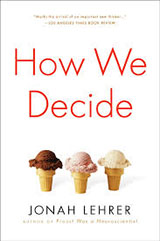My notes on “How We Decide” by Jonah Lehrer:
Which of the following 2 sentences of praise encourages kids to challenge themselves?
- “You must be smart at this” (intelligence)
- “You must have worked really hard” (effort)
The research revealed that the kids praised for their intelligence chose a puzzle of equal difficulty. Of the kids praised for their effort 90% chose a more difficult puzzle. When praising intelligence, the kids hear “look smart, don’t risk making mistakes”. The fear of failure actually inhibits learning.
Why are slot machines addictive? Dopamine.
Dopamine is the reward your brain delivers to the pleasure receptors in your brain when you make a correct decision. Over time it trains your brain, and creates shortcuts. The purpose of dopamine neurons is to predict future events. Unpredictable events deliver 3 to 4 times the dopamine.
Most of the time, the brain will eventually get over its astonishment. It’ll figure out which events predict the reward, and the dopamine neurons will stop releasing so much of the neurotransmitter. But the slot machines keep surprising your brain. That’s why the volume for the payouts are turned up so you hear them all in the room.
Loss aversion
“Loses loom larger than gains”. In Deal or No Deal, unless you are calculating probability, you feel the pain of loss after losing a case with a big amount of cash, and become less likely to settle for the banks offer because it feels like you are losing the difference, and continue to gamble on getting the next biggest reward.
Credit Cards dull the feeling of loss aversion because it doesn’t feel like you are parting with your money, you are just swiping a piece of plastic. That’s why you get a shock when you see your bill. Budget advisors chop up the credit cards first, and insist everything is paid for with cash.
Framing
You are given $50 and asked to decide between 2 options.
- Option 1 is all-or-nothing gamble. There is a 40% chance that you will keep the $50, and 60% chance of losing the lot.
- Option 2 is a sure thing, you get to keep $20.
Which option do you choose?
Most people choose the real thing.
Let’s play again, this time option 1 is unchanged, you have 40% chance of keeping the entire $50. But this time the sure thing is a loss of $30.
Which do you choose this time?
The 2 gambles are identical!
But the descriptions strongly affect how people play. When framed as a gain of $20, 42% chose it.
When framed as a loss of $30, 62% chose to roll the dice.
The Lesson: Think. It helps control emotional reactions.
Thinking too much
From the Consumer Reports test of 45 jams, 5 were chosen for a study on students. Statistically the ranking was very similar. Our brains are able to automatically pick out the products that provide us with the most pleasure.
In the second experiment, a second group of students were asked to explain why they had made the choices they did. They filled in questionnaires after each tasting.
This process destroyed their results.
There was no relationship between their results and those of the pros.
Thinking too much caused them to focus on all the variables that don’t actually matter.
Our rational brains search for reasons to prefer one option over another.
When choosing between a house in the suburbs with an extra bedroom but a 40 minute commute, and a house with a 10 minute commute, the more you spend deliberating, the more important that extra space becomes.
“They’ll imagine all sorts of scenarios that turns the extra bedroom into a necessity, whereas the lengthy commute seems less and less significant”.
Mistake.
When a person travels more than one hour in each direction, he or she has to make 40% more money in order to be satisfied with life.
When buying an energy drink on special, participants in another study solved 30% fewer puzzles than those who paid full price. They expected the cheaper goods to be less effective.
This is why brand-name aspirin works better than generic aspirin.
We can only store 5-9 pieces of information in our brains at once.
Half of the participants in another study were asked to memorise a 7 digit number and then asked to choose between cake and fruit. 50% chose the cake. Half the participants were asked to memorise a 2 digit number. 37% chose the cake.
The anchoring effect is commonly used on used cars. A high price is stated on the windshield, and you and the salesman chip away at that price. You think you’re getting a bargain, and that you’re doing well to haggle, but in reality the car is worth a fraction of the anchoring price.
One group of participants in another study only had all the information at their fingertips for chosing shares. The second group had only the share price to go on. The second group performed two times better.
This is counter-intuitive. When making decisions, people always assume more information is better.
How to make important decisions
- Have a good hard look at the options.
- Take a break and distract yourself for a while, and after that, make the decision.
This way you are using your conscious mind to acquire all the information you need for making a decision. But don’t try to analyse the information with your conscious mind. Take a long break, while your unconscious mind digests it.
Whatever your intuition then tells you is almost certainly going to be the best choice.
Why do flight simulators work so well for training pilots?
It allows pilos to internalise their new knowledge.
Instead of memorising lessons, the pilot is training their emotional brain, preparing the parts of the cortex that will actually make the decision when up in the air.
